| Designation: | BTR-60 |
 |
|---|---|---|
| Manufacturer: | Military Industrial Company LLC - VPK | |
| Product type: | Armoured Vehicles | |
| Name: | Modernization of the vehicle |
In the late 1950s, a Russian Army requirement was issued for a new wheeled APC to replace the non-amphibious BTR-152 (6 × 6) APC. Development of an 8 × 8 APC began in two competing design bureaus in 1957-58, this competition was called Project 49. The Dedkov OKB team won with its vehicle, the Type 62B. This was accepted for service with the Russian Army in 1960 under the designation BTR-60P.
The vehicle was seen in public for the first time during the November 1961 parade in Moscow. The BTR-60P (8 × 8) and its variants were normally used by the motorised rifle divisions, whereas the tank divisions have the tracked BMP-1/BMP-2 ICV. The original BTR-60P and BTR-60PA have been relegated to reserve, second-line or training use.
Production of the BTR-60 series was completed in 1976 and it is believed that total production amounted to around 25,000 vehicles, including the many variants.
Production of the BTR-60 series of 8 × 8 APC was undertaken at the Gorky Automobile Plant, which is today known as the Arzamas Machinery Plant, where production of the latest BTR-80 and BTR-80A (8 × 8) is undertaken for the export market on an as required basis.
A further development of the BTR-60PB has been manufactured in Romania under the designation of the TAB-71. More recently, Romania has produced another version called the TAB-77, which is now known to be based on the latest BTR-80 series APC. Full details of this are given in a separate entry.
The hull of the BTR-60P is of all-welded steel armour with the driver and commander seated at the front of the hull, the open-topped personnel compartment behind them and the engine compartment at the very rear of the hull. The interior of the BTR-60P is open from the driver and commander positions right through to the engine compartment at the rear.
The driver sits on the left with the vehicle commander to his right. Both have a windscreen in front of them which, when in action, is covered by a flap hinged at the top. This has an integral day vision device which can be replaced by an infra-red periscope for night use. To the left of the driver and the right of the commander is a vision block. Mounted above the flap in front of the commander is an infra-red searchlight which can be operated from inside the vehicle.
The infantrymen are seated on bench seats that run across the full width of the hull. In each side of the hull are two half doors and three firing ports. If required, bows and a tarpaulin cover can be fitted over the top of the troop compartment.
Main armament comprises a 7.62 mm SGMB or PKB machine gun which is pintle-mounted on the forward part of the hull. Some vehicles have been seen with the heavier 12.7 mm DShKM machine gun at this position. Mounts are also provided for 7.62 mm machine guns on either side of the hull.
The two 8-cylinder water-cooled petrol engines are mounted at the rear of the hull; the first and third axles are powered through the transmission of the right engine and the second and fourth axles through the transmission of the left engine. Torque is transmitted from each engine to the wheels through a single-plate clutch with hydraulic control, a four-speed gearbox with synchromesh in third and fourth gears, a two-speed transfer case, the final drives of the two driving axles with gearless differentials and four wheel reducers. Torque from the final drives to the wheel reducers is transmitted through half-axles and gimbal drive gears.
All eight wheels are powered and the first four, which are used for steering, are power assisted. The vehicle can be driven with one wheel missing from the second axle. The suspension is of the torsion bar type with the first and second road wheels on each side provided with two hydraulic shock-absorbers and the third and fourth road wheels with a single hydraulic shock-absorber. A central tyre-pressure regulation system, fitted as standard on all BTR-60 series APCs, enables the driver to adjust the tyre pressure to suit the ground being crossed.
The BTR-60P is fully amphibious and is propelled in the water by a single water-jet mounted at the rear of the hull. When not in use the exit at the rear of the hull is covered by a two-part circular plate. Before entering the water a trim vane is erected at the front of the hull and the bilge pump is switched on. When not in use the trim vane is stowed flat under the nose of the vehicle. Power is transmitted to the water-jet via a Power Take-Off (PTO) and water-jet reducer. Direction is changed when afloat by using a hydrodynamic rudder in the waterjet propeller and by turning the front four road wheels. To reverse direction, the shutters of the water-jets are closed and water is ejected through side ducts in the rear part of the vehicle that face forwards.
The basic BTR-60P does not have an NBC system as it is open-topped. All vehicles are fitted with infra-red night vision equipment and a front-mounted winch with a maximum capacity of 4,500 kg.
This model is also referred to as the BTR-60PK, and entered service in 1963. It has complete overhead armour protection for the troop compartment and is fitted with an NBC system. The commander and driver positions are identical to those on the original BTR-60P except that the driver has a roof-mounted day periscope and both have a single-piece hatch cover that opens to the rear.
Behind the commander and driver hatches is a single rear-opening rectangular hatch, in front of which is a single pintle-mounted 7.62 mm SGMB or PKB machine gun. Many vehicles also have a 7.62 mm machine gun mounted either side of this hatch cover. There is another hatch cover in the roof of the personnel compartment towards the rear on the right side, which opens to the right.
Three firing ports are provided in each side of the hull but no entry doors. The infantrymen are seated on bench seats along the side and rear of the troop compartment.
The BTR-60PB is essentially the BTR-60PA fitted with a machine gun turret and other modifications. In place of the vision blocks in the hatches immediately in front of the commander and driver, there are a number of roof-mounted day periscopes for observation to the front and sides of the vehicle.
The turret, which is identical to that fitted to the Russian BRDM-2 (4 × 4) amphibious scout car and the Czech OT-64 (8 × 8) APC, is armed with an unstabilised 14.5 mm KPV machine gun and a 7.62 mm PKT machine gun mounted coaxially to the right, with the telescopic day sight mounted coaxially to the left. The weapons have an elevation of +30°, a depression of -5° and the turret can be traversed through a full 360°. Gun elevation and depression and turret traverse are all manual.
To the rear of the turret on the right side is a single-piece hatch cover that opens to the left and to the left rear of this is a single-piece hatch cover that opens to the right.
There are single doors that open forwards either side of the hull and two or three firing ports and vision blocks.
The BTR-60PB was preceded by the BTR-60PAI, which also had a turret. Late production BTR-60PBs have the same sighting improvement as the BTR-70: a small additional periscopic sight on the turret roof.
This is a company commander's model of the BTR-60PB with two R-123 and one R-148 radios. The additional antenna mast on the left side of the hull can identify this version. Some vehicles have in addition been fitted with a retractable PIN STICK antenna.
This is an artillery observation post vehicle and is the wheeled equivalent of the tracked 1V14M with the same communications fit and the APPK computer/communications system.
The 1V18 Klen-1 has the US Army designation of the ACRV M1979/2a with the 1V18-1 being an improved version.
This is a fire direction centre vehicle and the wheeled equivalent of the 1V15M with the same communications fit and the APPK computer system. Wheeled variants of the other vehicles are the 1V110 on the GAZ-66 (1V13M) and the 1V111 on the ZIL-131 (6 × 6) (1V16M) chassis.
The 1V19 Klen-2 is also known as the ACRV M1979/2b and is equipped with a telescopic antenna for the R-130 on the left side of the hull. The IV19-1 is an improved model. Known users are Bulgaria, Finland, Romania, Russia and Serbia and Montenegro.
This is fitted with two R-111/171, one R-123/173, one R-130M and one R-8xx ground-to-air radio sets.
This is a forward air control vehicle with an unknown fit of R-8xx radio systems. This model has the standard turret. BTR-60 R-975MI is very similar but does not have a turret.
Fitted with an armoured generator system for high-power (for example 15 kW and larger) requirements.
Armoured field switchboard with one R-123M radio set. BTR-60-P-239BT is very similar.
Radio/wire integration switchboard with one R-405, one R-123M and switching equipment.
BTR-60 with a P-241 field telephone system. Fitted with a secure telephone terminal set.
BTR-60 with an armoured communication system with one R-137 VHF set, one R-405 and one R-123M radio. This is fitted with a turret but does not have a 14.5 mm KPV series machine gun.
BTR-60 with an armoured command and control communications system with one R-140 HF set, one R-405 and one R-123M radio. This is fitted with a turret but does not have a 14.5 mm machine gun.
Armoured command and control communications system vehicle with one R-156 HF set, one R-405 and one R-123M radio. This is not fitted with a turret.
BTR-60 used as an armoured radio relay station with one R-409 and one R-123M radio. This is not fitted with a turret.
Bulgarian BTR-60 with unidentified communications equipment for use by artillery units.
This is essentially the BTR-60P fitted with bows and a tarpaulin cover and internally with seats for the command staff, map boards and additional communications equipment. A command version of the BTR-60PA is also in service with a roof-mounted generator, a 10 m high radio antenna, which is used in the static role and a rail antenna running along the front, left side and rear of the hull. Variants of the BTR-60Pu include the BTR-60PuM and BTR-60PuM1.
This is a Finnish variant of the Pu (R-145BM) without the Hawk Eye or Clothes Rail antenna and is fitted with the 12.7 mm NSVT machine gun and modern communications equipment. This entered service with Finland in 1996.
This is an upgraded Bulgarian BTR-60PB with 81 mm smoke grenade launchers, VAMO DT 3900 or Rover TD-200 diesel engine, Melopa night vision equipment, new NBC system and modern radios.
The BTR-60MBP (Mashina Bojevogo Posta) is used as a security and escort vehicle for strategic missile units.
The BTR-60Pu-12 command and control vehicle has been in service with the former Soviet and now Russian Army since the late 1970s and has also been identified in service with Bulgaria, the former Czechoslovakia, Hungary and Serbia and Montenegro.
The vehicle is essentially a BTR-60PA with a large stowage box on the right side of the hull to the rear of which is a water or fuel can. On the roof is a box, which may house a generator to power the additional communications equipment installed. To the immediate rear of the commander's roof hatch is a telescopic mast, which is raised into the operating position by turning a handle located on the right side of the mast.
The BTR-60Pu-12 operates with air defence units equipped with systems such as the ZSU-23-4 self-propelled anti-aircraft gun, and 9K33 Osa (SA-8 'Gecko') and 9K35 Strela 10 (SA-13 'Gopher') self-propelled surface-to-air missile systems.
The BTR-60Pu-12 is also known as the 9S482 with the BTR-60Pu-12M being the 9S482M.
The main improvement of the -12M is the installation of the new ASPD-U computer instead of the older ASPD-12. As a result the command post can now treat 99 targets simultaneously instead of only 20.
The Pu-12 and Pu-12M command post vehicles are based on the BTR-60PB chassis, not the BTR-60PA. In fact, virtually all of the BTR-60 variants are based on the BTR-60PB, with the exception of the MTP-2 and the Bulgarian BTR-60PAU.
A number of older BTR-60P (8 × 8) APCs have been converted for use in the maintenance assistance role and have a raised tarpaulin cover over the troop compartment that runs almost to the rear. This may have the Russian designation of the MTP-2 (Mashina Tekhnicheskoj Pomoshchi). This is based on the BTR-60P with a higher roof line or the BTR-60PA and has a small crane that is mounted on the front when in use. In addition, there is also a version based on the BTR-60PB.
This is the BTR-60P series used in the radio role and fitted with a 'High Ball' (NATO designation) telescopic antenna.
The Cuban Army has used a modified BTR-60P with the former Czech twin 30 mm towed anti-aircraft gun system mounted in an open mount on top of the vehicle.
This is essentially the BTR-60PB with the armament removed from the turret and the resulting port covered by a plexiglass observation window. To provide power for the additional communications equipment carried, a generator is mounted externally on the top of the hull at the rear.
These include P-219, P-238BT, P-239BT and P-241BT, P-240, P-240BR, P-240BT and P-240TBR, P241TBR, P251, P-286, P-537, R118AM3, R-137, R-137B, R-137BR, R-140, R-145BM, R-145K and MB R-145, R-156, R-156B, R-156BTR, R-396, R-409, R-409BM and R-409BR, R-419B, R-419BR, R-419BTR, R-440B, R-975, R975M and R-975M1, Z-351BR, BMU, EPS, KOAM, BTR-60KShM, BTR-60MS and BTR-60 Salon.
Djibouti has fitted at least one of its Russian BTR-60 (8 × 8) APCs with the complete turret of the French Panhard General Defense AML-90 (4 × 4) armoured car. This is armed with a 90 mm rifled gun fitted with a muzzle brake and a 7.62 mm coaxial machine gun.
The vehicle is called the BTR-60 H 90 and was also fitted with the hydraulic aiming system of the AMX-13 light tank.
Djibouti has also fitted the US-supplied HMMWV (4 × 4) with the complete turret of the Russian BRDM-2 (4 × 4) armoured car armed with a 14.5 mm and 7.62 mm machine gun.
Following the reduction in the size of the Russian Army, many BTR-60 vehicles are now surplus to requirements and some are being converted into civilian vehicles. These include the technical assistance vehicle MTP-2B and the disaster assistance transporter ATM-2, both of which have been developed by the Kaunas Vehicle Repair Factory.
The Arzamas Machinery Plant has now developed and completed testing of an upgrade package for the widely deployed BTR-60/BTR-70 series of 8 × 8 APC.
The existing power pack of the BTR-60 has been replaced by the complete power pack of the more recent BTR-80 series of 8 × 8 APC, as well as its associated transfer case and drive shafts.
The power pack includes a single KamAZ-7403 V-8 turbocharged diesel developing 260 hp, which gives the vehicle a maximum road speed of up to 100 km/h and an operating range of 600 km/h.
The installation of the new diesel power pack not only increases the speed and range of the BTR-60 but also reduces the risk of fire and helps a common fuel policy, as all new armoured fighting vehicles today have a diesel engine fitted as standard.
The existing turret has been replaced by the more recent BPU-1 turret as fitted to the standard production BTR-80 that has similar weapons but elevation has been increased to +60°. This allows the weapons to engage slow and low-flying aerial targets, as well as targets in higher buildings when engaged in urban operations.
Armour protection has also been improved and standard equipment includes fire detection and suppression equipment, NBC system and a life-support system.
The existing communication equipment has been replaced by the more recent R-168-25U or R-173 system and a Gamma-2 land navigation system fitted.
Combat survivability is claimed to have been improved by the installation of additional passive armour protection. Other improvements include new commander's and driver's vision devices, new bulletproof tyres, new waterjet and improved seating arrangements.
The upgraded BTR-60 can also be fitted with the latest BPPU one-person turret armed with an externally mounted 30 mm 2A72 cannon and 7.62 mm PKTM coaxial MG.
In the baseline model the 30 mm 2A72 cannon is not stabilised but a stabiliser can be fitted as an option, which increases hit probability against moving targets.
The BPPU turret has already been produced in production quantities for the BTR-80A vehicle that is in service with Russia and has already been exported to a number of countries.
The Muromteplovoz company has developed to the prototype stage an extensive upgrade for the BTR-60PB APC covering firepower and mobility.
The standard production BTR-60PB is fitted with a turret similar to that installed on the BRDM-2 armoured car armed with a 14.5 mm and 7.62 mm machine gun.
For this upgrade this turret has been removed and replaced by a new MB2 turret (or combat compartment as the Russians call it) which is armed with a 30 mm 2A42 cannon and a 7.62 mm PKTM machine gun with a 30 mm AG-17 grenade launcher mounted extremely on the left side of the turret.
These weapons can be elevated up to +60 degrees which enables the weapons to be used in urban situations as well as against slow flying aircraft and helicopters.
The MB2 turret has also been installed on other tracked and wheeled chassis and is available with a stabilisation system and various day/night sighting systems.
Other weapon systems are also being marketed including the more recent 30 mm 2A72 cannon as well as the 23 mm GSh-23 and 30 mm GSh-30 cannon. Air defence and anti-tank guided weapons can also be added including the laser-guided Kornet. The latter has a maximum range of 5,000 m and can be fitted with various tyes of warhead.
The standard production BTR-60PB was powered by two GAZ-49B 6-cylinder in-line petrol engines that developed 90 hp each to give the vehicle a maximum road speed of 80 km/h and a road range of 500 km.
In the upgraded BTR-60PB the rear hull has been modified and a new YaMZ-236A four stroke diesel installed which develops 195 hp. This gives the vehicle a maximum range of 800 km and a maximum speed of 80 km/h. The transmission has also been upgraded and braking system improved.
For the upgraded BTR-60PB weight has increased to 13 tonnes so power-to-weight ratio has dropped to 15 hp/tonne. Maximum torque has been increased by 62 per cent and while the original BTR-60PB could accelerate from 0 to 60 km/h in 83 seconds the upgraded version can accomplish this in only 63 seconds.
In mid-2007 the Muromteplovoz company showed a much modified BTR-60P (8 x 8) chassis fitted with the 9K35M3-K Streka-10M3-K (SA-13 'Gopher') which is normally installed on the MT-LB full tracked chassis.
This has power operated turret with four surface-to-air missiles in the ready to launch position which is mounted on a much modified BTR-60P chassis.
To accommodate the missile launcher the sides of the hull have been extended outwards above the second and third road wheel stations to create greater internal volume.
The original two petrol engines have been replaced by a more fuel efficient YaMZ-236A diesel developing 195 hp which gives a maximum road speed of 80 km/h and a claimed operating range of 800 km. The transmission has also been upgraded and braking system improved.
This diesel powerpack is also installed in the previously mentioned Muromteplovoz BTR-60.
For the air defence application the rear engine deck appears to be higher which may indicate further improvements including perhaps an auxiliary power unit.
Late in 2001, Iran announced that it had upgraded and repaired 30 Russian built BTR-60PB (8 × 8) APCs that had been damaged in the 1980-88 and 1990-91 Gulf conflicts with Iraq.
According to Iranian sources, the upgrade has given the vehicle improved cross-country mobility as well as increasing maximum road speed to 80 km/h and water speed to 10 km/h.
It is considered probable that the upgrade included replacing the two original petrol engines with one or two more fuel-efficient diesel engines.
In response to an undisclosed overseas customer, Israel's NIMDA has developed an upgrade package for the BTR-60 APC.
The old power pack has been replaced by a new NIMDA-developed diesel power pack, coupled to new fully automatic electronic transmission.
The complete power pack consists of two Rover 300 TDI diesel engines, two Allison 1000 series automatic transmissions and two separate cooling systems, including hydraulic fans.
A modification kit for the driver's control systems and a transmission control lever or push-button box is provided.
The new engines and transmissions are supported by a recently developed cooling system that comprises radiators and hydraulically operated fans. This enables the vehicle to operate in extreme environmental conditions from -40 up to +45°C.
This upgraded vehicle has a maximum speed (fourth gear) of 90 km/h and 120 km/h (fifth gear), with an operating range of between 650 to 750 km.
|
||||||||||||||||||||||||||||||||||||||||||||||
Related Articles |
|
At Defense And Security 2005 3 rd International Exibition Of Defense And Security Technology (25.07.2005) |
|
The Russian Army Has Completed the Trials of the BTR-90 Armoured Personnel Carrier (11.01.2005) |
|
Chief Designer Who Was Well Ahead of His Time (27.10.2004) |
 |
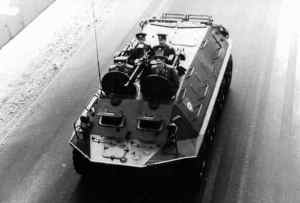 |
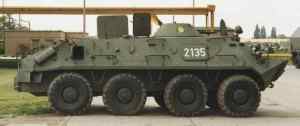 |
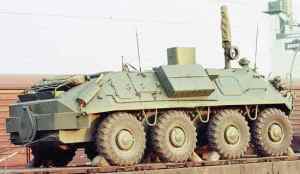 |
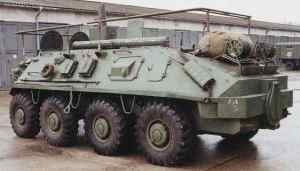 |
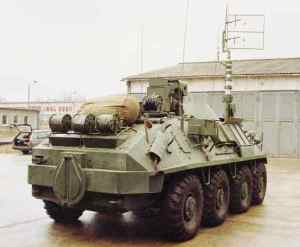 |
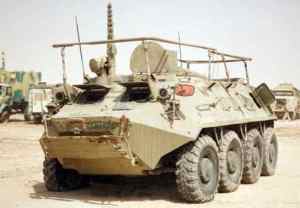 |











































